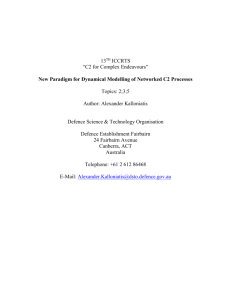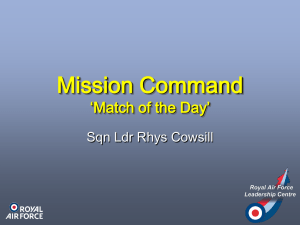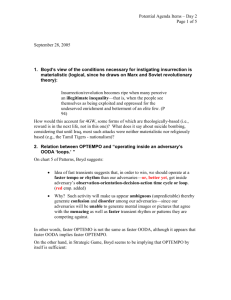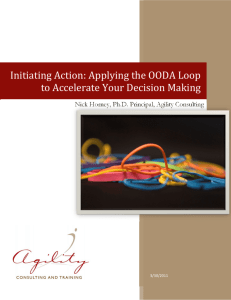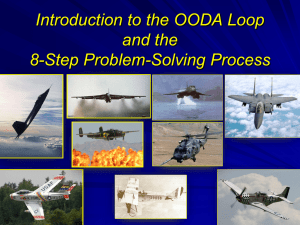“OO-OO-OO!” The Sound of a Broken OODA Loop
advertisement
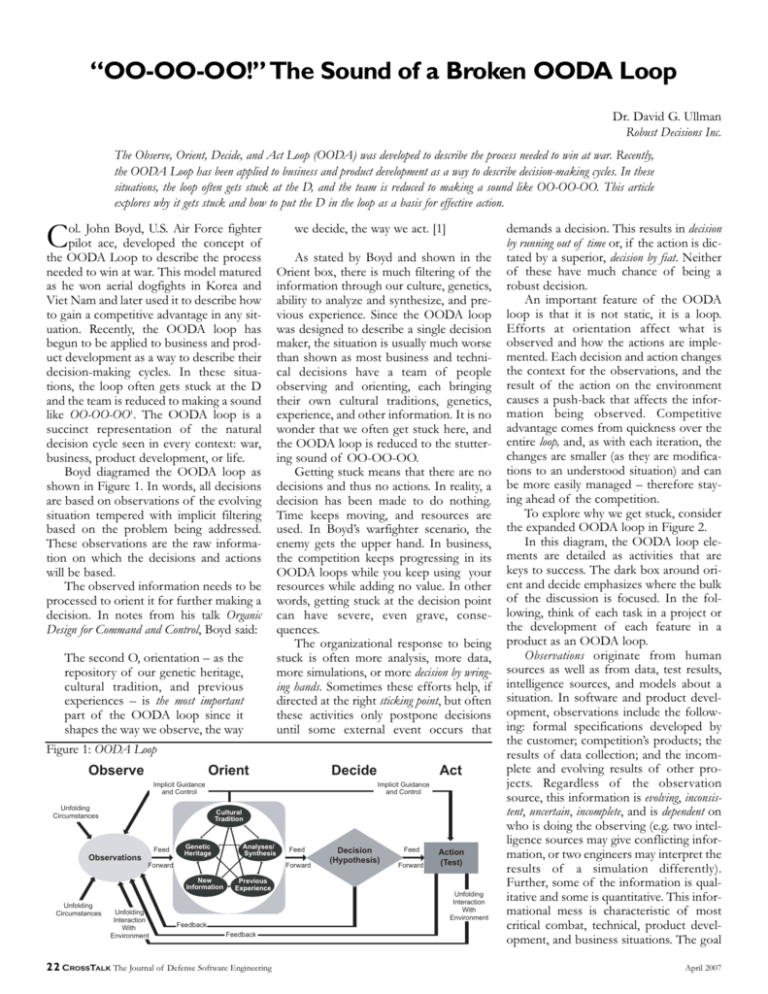
“OO-OO-OO!” The Sound of a Broken OODA Loop Dr. David G. Ullman Robust Decisions Inc. The Observe, Orient, Decide, and Act Loop (OODA) was developed to describe the process needed to win at war. Recently, the OODA Loop has been applied to business and product development as a way to describe decision-making cycles. In these situations, the loop often gets stuck at the D, and the team is reduced to making a sound like OO-OO-OO. This article explores why it gets stuck and how to put the D in the loop as a basis for effective action. C ol. John Boyd, U.S. Air Force fighter pilot ace, developed the concept of the OODA Loop to describe the process needed to win at war. This model matured as he won aerial dogfights in Korea and Viet Nam and later used it to describe how to gain a competitive advantage in any situation. Recently, the OODA loop has begun to be applied to business and product development as a way to describe their decision-making cycles. In these situations, the loop often gets stuck at the D and the team is reduced to making a sound like OO-OO-OO1. The OODA loop is a succinct representation of the natural decision cycle seen in every context: war, business, product development, or life. Boyd diagramed the OODA loop as shown in Figure 1. In words, all decisions are based on observations of the evolving situation tempered with implicit filtering based on the problem being addressed. These observations are the raw information on which the decisions and actions will be based. The observed information needs to be processed to orient it for further making a decision. In notes from his talk Organic Design for Command and Control, Boyd said: The second O, orientation – as the repository of our genetic heritage, cultural tradition, and previous experiences – is the most important part of the OODA loop since it shapes the way we observe, the way Figure 1: OODA Loop Observe we decide, the way we act. [1] As stated by Boyd and shown in the Orient box, there is much filtering of the information through our culture, genetics, ability to analyze and synthesize, and previous experience. Since the OODA loop was designed to describe a single decision maker, the situation is usually much worse than shown as most business and technical decisions have a team of people observing and orienting, each bringing their own cultural traditions, genetics, experience, and other information. It is no wonder that we often get stuck here, and the OODA loop is reduced to the stuttering sound of OO-OO-OO. Getting stuck means that there are no decisions and thus no actions. In reality, a decision has been made to do nothing. Time keeps moving, and resources are used. In Boyd’s warfighter scenario, the enemy gets the upper hand. In business, the competition keeps progressing in its OODA loops while you keep using your resources while adding no value. In other words, getting stuck at the decision point can have severe, even grave, consequences. The organizational response to being stuck is often more analysis, more data, more simulations, or more decision by wringing hands. Sometimes these efforts help, if directed at the right sticking point, but often these activities only postpone decisions until some external event occurs that Orient Decide Implicit Guidance and Control Unfolding Circumstances Cultural Tradition Feed Observations Genetic Heritage Analyses/ Synthesis Forward Unfolding Interaction With Environment 22 CROSSTALK The Journal of Feed Forward New Information Unfolding Circumstances Act Implicit Guidance and Control Decision (Hypothesis) Feed Forward Action (Test) Previous Experience Unfolding Interaction With Environment Feedback Feedback Defense Software Engineering demands a decision. This results in decision by running out of time or, if the action is dictated by a superior, decision by fiat. Neither of these have much chance of being a robust decision. An important feature of the OODA loop is that it is not static, it is a loop. Efforts at orientation affect what is observed and how the actions are implemented. Each decision and action changes the context for the observations, and the result of the action on the environment causes a push-back that affects the information being observed. Competitive advantage comes from quickness over the entire loop, and, as with each iteration, the changes are smaller (as they are modifications to an understood situation) and can be more easily managed – therefore staying ahead of the competition. To explore why we get stuck, consider the expanded OODA loop in Figure 2. In this diagram, the OODA loop elements are detailed as activities that are keys to success. The dark box around orient and decide emphasizes where the bulk of the discussion is focused. In the following, think of each task in a project or the development of each feature in a product as an OODA loop. Observations originate from human sources as well as from data, test results, intelligence sources, and models about a situation. In software and product development, observations include the following: formal specifications developed by the customer; competition’s products; the results of data collection; and the incomplete and evolving results of other projects. Regardless of the observation source, this information is evolving, inconsistent, uncertain, incomplete, and is dependent on who is doing the observing (e.g. two intelligence sources may give conflicting information, or two engineers may interpret the results of a simulation differently). Further, some of the information is qualitative and some is quantitative. This informational mess is characteristic of most critical combat, technical, product development, and business situations. The goal April 2007 “OO-OO-OO!” The Sound of a Broken OODA Loop of orient is to reduce this mess so we can decide what to do next and take action – collect more information, involve more people, or turn our attention to other OODA loops. The goal of orientation is to make sense of the observations. This requires understanding the observations as a basis for choosing the best course of action. In many cases, formal analysis can help reduce this fog, but much of the information cannot be easily modeled. Thus, how this information is managed to match the human decision-makers’ needs is crucial. Orientation also is dependent on viewpoint. Even on the same team, how the observations are understood is dependent on who is trying to understand them. As Boyd pointed out, understanding is dependent on previous experience, cultural traditions, and genetic heritage. Beyond these measures, understanding is also dependent on one’s role in the organization and team objectives. Helping a team make sense of the situation and develop a shared understanding while honoring the different viewpoints is a challenging but necessary part of getting team buy-in and making a robust decision. Orientation should aid in the sharing of implicit knowledge. By this we mean that in trying to make sense of the situation and fuse the observations, some of the stakeholder’s implicit knowledge must become explicit and be communicated to others. Often the OODA loop stalls because the decision makers are not comfortable with the uncertainty. Managing uncertainty implies that beyond concern there is an effort to do the following: measure the uncertainty, control what you can, and minimize the effect of that which you cannot control. Uncertainty creates risk that a poor decision will be made. This is over and above traditional risk consideration – risk based on past statistics that give information on the probability of occurrence and consequence. Since decisions require a look into the evolving future, traditional probability methods (often called frequentist methods) for managing risk and uncertainty cannot be applied. Recently, Bayesian methods have been used to help manage these situations (see item in 4c, to follow). A key part of orientation is developing alternative courses of action. In the words of the French philosopher Emile Chartier, “Nothing is more dangerous than an idea when it is the only one you have.” In engineering design and software development, this means actively searching for multiple options to consider. Making a decision is not a single action, April 2007 Observe Orient Decide Implicit Guidance and Control Act Implicit Guidance and Control Human Sources Observations are: - Evolving - Inconsistent - Uncertain - Incomplete - Dependent Orientation includes: - Sense-making - Managing alternate viewpoints - Sharing implicit knowledge - Managing uncertainty and risk - Developing courses of action Decisions: - Managing deliberation - Fusing information - Choosing what to do next Action Data and Models Intelligence Figure 2: Expanded OODA Loop but is a process of repeatedly deciding what to do next – observe more information, do further orientation, or take action. A major component of this is managed deliberation, which is synergistic with Orient, as it is part of sense-making and can help lead to a shared vision of observations. Managed deliberation implies the following: • Identifying the areas on which to focus based on benefit of further effort. This is a major sticking point in the OODA loop. It is often difficult to see where more work needs to be focused. The benefit is usually hard to measure, but it should be in terms of the following: 1) anticipated change in satisfaction with a course of action, 2) anticipated change in the risk with a course of action, or 3) anticipated consensus or buy-in from management or team members. • Identifying the cost of further effort. This also is a major sticking point in the OODA loop. The cost of doing more work is usually in terms of the time used and the expense for researching, testing, or consulting. • Identifying areas where consensus is low and impact is high. The goal here is to separate areas that need effort (consensus is low and impact is high) from points that are not critical to a decision. Part of choosing what to do next is separating out what is easy to do from what will actually provide understanding needed to make a decision. • Managed deliberation implies OODA loops inside OODA loops as the decision about that to work on next requires its own OODA activities. Deciding what to do next requires fusion of the orientation results. As with the observations, the result of orientation is usually evolving, inconsistent, incomplete, uncertain, and dependent on who is doing the orientation. Somehow, this ori- Unfolding Interaction With Other OODA Loops ented information must be fused to develop a picture of the situation that is cognitively small enough to decide what to do next. Fusion may be both an analytical effort and a consensus building effort. Analytical methods range from formal optimization to methods that combine the subjective opinions of team. More importantly is building collaboration to get buy-in on the chosen action. Collaboration requires that the following is present: • Everyone can paraphrase the issue to show that it is understood. • Everyone has a chance to contribute to the solution of the problem. • Everyone has a chance to describe what is important. Those who do not agree with the final decision will more likely support the team because they have been included in the decision-making process and appreciate the compromise needed to reach a decision The proof of the success of the OODA loop is in the success of the Action taken. Here, think of actions as work activity or pieces of information that affect work activity. All action affects future observations. In Why Decisions Fail, [2] the author studied 400 decisions made by senior managers in medium to large organizations. He considered the decision a success if it was sustained for two years after the decision was made. In other words, the action taken had noticeable impact two years later. He found that fully half of the decisions failed to have any impact beyond the use of resources. It is clear that many decisions in information technology OODA loops fail. According to the 2004 Chaos Report [3], 53 percent of products are delivered late or over-budget, and an additional 18 percent are cancelled. Further, projects completed by large companies have only 42 percent of the originally designed features and funcwww.stsc.hill.af.mil 23 Software Engineering Technology tions. Features and functions are often jettisoned during a project to help meet schedule and budget. This is often referred to as descoping a project; some organizations build descoping into their original plans. The Chaos Report numbers may be worse than stated as they are self-reported. Guidelines for Unsticking the OODA Loop As ubiquitous and important as the OODA loop is, most of us receive little training in how to perform the two key elements of orient and decide. Sure, we pick up some clues from our formal training, yet we are never formally trained in the OODA elements. Even in military training [4], there is little detail about how to manage them. Itemized here are a few guidelines for staying unstuck and for making robust decisions, especially in product and software development. The Entire OODA Loop: 1a. Identify the OODA loops in your organization and their interactions. Each OODA loop provides the environment for other interacting OODA loops. Consider each task or feature development as an OODA loop and think through O-O-D-A. 1b. For each OODA loop, ensure you know who the resulting actions will affect because they, in turn, may affect your observations as your loop is refined. Observe 2a. Make sure you know the properties of observations. Each piece of information comes with details about its stability, consistency, certainty (see 2b), completeness, and its dependence on the observer. Note these and formalize them, if possible. 2b. All observations are uncertain. Early in the design of a system, uncertainty is dominated by lack of knowledge – cognitive uncertainty. As systems mature, most uncertainty is due to natural variance in the environment and nature of materials. In software development, variation is small compared to cognitive uncertainty. Anytime anyone gives you an estimate, the results of a simulation or experiment, or an opinion, you must tag it with a level of certainty. You need to make this explicit. Engineers and financial analysts in particular are prone to giving single, deterministic values for information that is really a distribution. Push back on them to find the distribution, even if it is in terms such as very 24 CROSSTALK The Journal of Defense Software Engineering sure, about, or sort-of. Early in the development of a system, all estimates are uncertain and need to be managed as such (see item 3d). Orient 3a. Since orientation is so important, it is amazing that more emphasis is not put on its component parts. The major function of orientation is making sense of the observations. Since all observations are understood only in relation to what the orienter knows; sense is different to each person presented with the observations. Thus, one sticking point is when the person responsible for the OODA loop does not have sufficient knowledge to orient and knows it. This realization may take awhile. Thus, if responsible for a decision and it is not happening, ask if it is because of insuf- “... understanding is dependent on previous experience, cultural traditions, and genetic heritage. Beyond these measures, understanding is also dependent on one’s role in the organization and team objectives.” ficient knowledge to make sense of the situation. If so, find people who do have the knowledge. 3b. If a problem is sufficiently complex that a team is involved, then each person on the team has a different context for orienting. Here, sense making is communal and challenging so no one person has either a complete picture or the capability of developing one. It is possible to have meetings to discuss the observations without significant sense making. The key is to set up environments that support sense making by sharing pertinent information needed for the decision. Implicit knowledge needs to be made explicit in a form that is understandable by others who have a different context for understanding the observations. 3c. In a team situation, during orientation, there will be multiple viewpoints about what is important. It is necessary to separate what is important from what is to be achieved. For example, the cost of an alternative may be very important to some and not as important to others. This fact needs to be separated from the estimated cost of each alternative being considered. The uncertainty in the estimate may swamp the differences in importance, but only if this separation is made explicit. To restate this, separate out what is to be achieved (i.e. goals, targets) from how important it is to achieve them. Further, disagreements about what is important can be an asset as management of them can support collaboration leading to action buy-in. 3d. Since observations are uncertain, orientation methods need to be able to manage uncertain information whether quantitative or qualitative. The risk of not making a robust decision is dependent on managing this uncertainty. One way to tackle uncertainty in software development is through simulation and testing across the range of the uncertainty. This has been formalized through the use of design of experiments (DOE) and Taguchi methods [5]. 3e. During orientation, make sure you are considering multiple courses of action and can itemize them. Develop methods within your organization that encourage this. Find ways to help the champions of each idea compare and contrast their alternatives with others. Decide 4a. Making a decision is essentially deciding what to do next. The default is to do nothing – getting stuck on OO-OOOO. Being stuck is a clear call for any of the following: • Build consensus with the information you have. This pushes back on orientation – managing viewpoints, sharing implicit knowledge, collaborating, and developing new courses of action. This is the first choice about what to do as it is the most cost effective. • Perform more analysis to refine the orientation information. This is generally more expensive than working with the information you have and can lead to paralysis by analysis – the risk-averse activity of trying to drive out all uncertainty by undertaking increasingly higherfidelity simulations of the situation. When the fidelity of the simulations is superior to the certainty April 2007 “OO-OO-OO!” The Sound of a Broken OODA Loop of the observations on which the simulations are based, time and money are being wasted. • Return to observation and collect more information. This is almost always more expensive and time consuming than the previous two options. If the information that will reduce the risk and unstick the decision is collectable, it may be worthwhile. 4b. Work toward learning from past decisions. Knowing how well you are doing requires keeping track of decisions made, the actions that follow, and the success of the actions (i.e. did they stick?). This is seldom done in a fashion that makes it possible to learn from OODA loop successes and failures. 4c. Develop methods that manage the fusion of uncertain observations and orientation in support deciding what to do next. Formal tools that help you do this are just being developed. Since decisions are based on uncertain estimates of the future, Bayesian methods are ideal for supporting such activities [6]. In one such effort developed by the author, Bayesian tools are packaged in a distributed team decision-support system. In this system, there is no need to understand the Bayesian mathematics that are hidden behind an easy-touse graphical user interface. This system attempts to estimate the risk of making a poor decision and, in many ways, supports the management of the uncertain observations and orientation. Act 5a. A decision that has both high buy-in and accountability naturally generates actions that are aligned with the decision made. The opposite is also true. If a decision is made and it is not followed by consistent actions, then the problem may lie in earlier OODA activity (especially see items 3b, 3c, 4a, and 4c). 5b. Associate the actions taken with specific OODA loops (e.g. tasks). If you cannot identify where an action initiated then it may be an assumption that has no formal OODA activity behind it and may be spuriously driving other loops. Think of actions as any work effort or piece of information that is affecting work effort. In summary, the OODA loop model is an easy way to think about your product development effort. It can help focus on problems that occur along the way – especially if you hear your organization stuttering OO-OO-OO. Following these guideApril 2007 lines can help unstick your OODA loops.◆ References 1. Boyd, J. “Organic Design for Command and Control” <www.d-n-i. net/boyd/pdf/c&c.pdf>. 2. Nutt, Paul C. Why Decisions Fail. Berrett-Koehler Publishers, 2002. 3. The Standish Group. “2004 Third Quarter Research Report: CHAOS Demographics.” <www.standishgroup. com/sample_research/index.php>. 4. “Commander’s Estimate of the Situation.” NWC 4111e. Mar. 2002. Naval Operations Planning, Naval Warfare Publication May 2001 (formerly NWP11). 5. Phadke, Madhav. “Design of Experiments for Software Testing.” iSixSigma Magazine Jan. 2003 <www.isixsigma. com/library/content/c030106a.asp>. 6. D’Ambrosio, Bruce. “Bayesian Methods for Collaborative DecisionMaking.” Robust Decisions <www. robustdecisions.com/bayesianmethod decisions.pdf>. Note 1. The sound “OO-OO-OO” was verbally described in a presentation by Harvey S. Gold, lead design for Six Sigma and Black Belt, DuPont CR&D, June 2005. About the Author David G. Ullman P.E., Ph.D., (Emeritus Professor of Design, Oregon State University) has researched design and decision making for more than 25 years. Recently, his research has focused on the importance of decision-making in the product realization process. He is an active software and hardware designer. His recent book, Making Robust Decisions, was published in December, 2006. Additionally, he is the author of The Mechanical Design Process, 3rd edition. He is an American Society of Mechanical Engineers Fellow and a registered Professional Engineer. Robust Decisions, Inc. 1655 Hillcrest DR Corvallis, OR Phone: (541) 758-5088 (541) 754-3609 E-mail: ullman@robust decisions.com Get Your Free Subscription Fill out and send us this form. 517 SMXS/MXDEA 6022 Fir Ave Bldg 1238 Hill AFB, UT 84056-5820 Fax: (801) 777-8069 DSN: 777-8069 Phone: (801) 775-5555 DSN: 775-5555 Or request online at www.stsc.hill.af.mil NAME:________________________________________________________________________ RANK/GRADE:_____________________________________________________ POSITION/TITLE:__________________________________________________ ORGANIZATION:_____________________________________________________ ADDRESS:________________________________________________________________ ________________________________________________________________ BASE/CITY:____________________________________________________________ STATE:___________________________ZIP:___________________________________ PHONE:(_____)_______________________________________________________ FAX:(_____)_____________________________________________________________ E-MAIL:__________________________________________________________________ CHECK BOX(ES) TO REQUEST BACK ISSUES: D EC 2005 c TOTAL CREATION OF SW JAN2006 c COMMUNICATION FEB2006 c NEW TWIST ON TECHNOLOGY MAR2006 c PSP/TSP APR2006 c CMMI MAY2006 c TRANSFORMING JUNE2006 c WHY PROJECTS FAIL JULY2006 c NET-CENTRICITY AUG2006 c ADA 2005 SEPT2006 c SOFTWARE ASSURANCE OCT2006 c STAR WARS TO STAR TREK NOV2006 c MANAGEMENT BASICS DEC2006 c REQUIREMENTS ENG. JAN2007 c PUBLISHER’S CHOICE FEB2007 c CMMI MAR2007 c SOFTWARE SECURITY To Request Back Issues on Topics Not Listed Above, Please Contact <stsc. customerservice@hill.af.mil>. www.stsc.hill.af.mil 25
